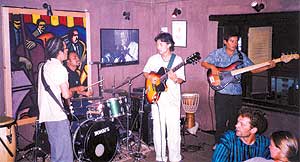 It is an experience many music-lovers in this city have had at least once. Friends come in from out of town. Eager to impress them, you decide the thing to do on Saturday night is catch good, live music. Jazz. In Kathmandu. You make your way to the Upstairs Jazz Bar in Lazimpat. The reaction is along the order of a lepidopterist discovering a prize butterfly in the heart of Manhattan.
It is an experience many music-lovers in this city have had at least once. Friends come in from out of town. Eager to impress them, you decide the thing to do on Saturday night is catch good, live music. Jazz. In Kathmandu. You make your way to the Upstairs Jazz Bar in Lazimpat. The reaction is along the order of a lepidopterist discovering a prize butterfly in the heart of Manhattan. Five years ago, Cadenza was just another band in Kathmandu, started by boys from Darjeeling, playing covers. Today, if you don't know who they are, you don't know your jazz. Since Cadenza last featured in these pages (#17), its weekend performances have become an integral part of the city's cultural calendar.
Part of the reason the band attracts so many new fans is that it keeps innovating and trying new kinds of jazz, and new takes on old forms. Their rendition of Louis Armstrong, John Coltrane and Ella Fitzgerald standards is superb, and when they bring out that djembe-which they do regularly now-it makes for a surreal experience as the streets of 1950s Cuba and Puerto Rico come alive in Kathmandu. The ghosts of Tito Puente and Mongo Santamaria take a bow and the band takes off.
But that's only on the weekend. On occasional Wednesdays, they perform a different kind of fusion-with percussionists skilled in Hindustani classical music. Nabin Chhetri, the charismatic drummer and vocalist, tries his hand at all kinds of percussion sounds, even as the rest of the band plays straight ahead jazz to complement the Wednesday night classical beats. Not bad for someone who started playing drums barely six years ago. This versatility is typical of the band-guitarist Jigme Sherpa, for instance, takes a turn or two on the djembe or conga on Saturdays.
The music attracts a surprisingly diverse crowd-young and old, college students and socialites, architects, doctors, journalists, expats of all shades, from embassy official to VSO volunteer, rafting freaks and other musicians. Cadenza and Upstairs do that rare thing-attract jazz aficionados, while also converting new people to the joys of improvised music that is both funked-up and cerebral.
Cadenza didn't always play jazz. Nabin formed a band with a couple of friends in the mid-1990s, but three years ago they decided to pursue the American dream. Nabin stayed back and played with people here and there, mostly in Thamel, it is an experience he is glad he had. "The good thing about playing in Thamel was we were exposed to the world. There would be the odd tourist who wanted to jam with us-and turn out to be a real pro," he says. It was these passers-by who led Nabin to discover jazz. He had to keep the band going, and so convinced his brother, long-time friend Chi, and Jigme to leave Darjeeling for Kathmandu. They formed Cadenza, and last year, after they had been playing together two years, they were invited to the Palmer Street Jazz Festival in Australia where, by all accounts, they were a huge hit.
Cadenza is so sure of its improvisational and cross-genre skills that on Saturday, 13 October, it is putting on a fusion show at the Patan Museum Caf? to celebrate 100 years of jazz. A hundred years of jazz and the 101st anniversary of Duke Ellington couldn't be celebrated better. This sort of thing is why Cadenza is not going out of style any time soon. And why the band's name is so appropriate-it comes from \'cadence'-the movement of sound, an improvisation.


